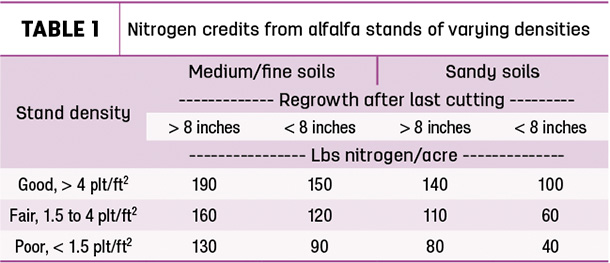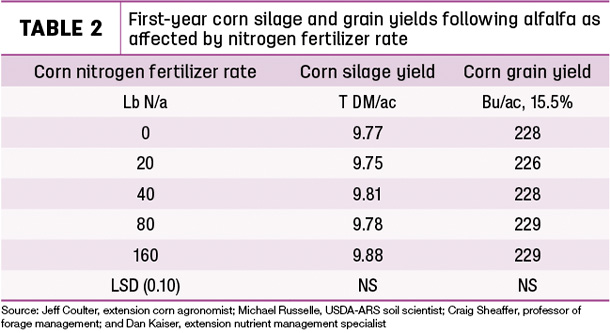Fertilizer prices have gone up tremendously recently. Anhydrous nitrogen is $1,250 to $1,400 per ton as of Dec. 1, 2021, and many dealers are not taking orders for spring, expecting the price to increase even further. One potential for farmers is to terminate thin alfalfa stands. Table 1 shows the nitrogen one can expect from a terminated alfalfa stand.

Stands with four plants per square foot will often have 25% to 30% reduced yield compared to an alfalfa stand with good density and irrigation or adequate rain. However, this stand, if terminated, will result in 150 to 190 pounds per acre of nitrogen for the next crop on a medium to fine soil.
Table 2 shows the results of five trials conducted in Minnesota where corn was planted into a terminated alfalfa field and nitrogen fertilizer added at varying rates.

In no case did the nitrogen fertilizer increase yield of either corn silage or grain. The same results would be expected for sorghum, since it has about the same nitrogen requirement as corn.
Studies in Manitoba have shown that wheat planted into a terminated alfalfa yield showed no benefit from nitrogen fertilizer for two or more years. Further, the wheat planted into the alfalfa residue averaged 1% higher protein in the grain when harvested.
Since corn or sorghum planted into terminated alfalfa stands do not need nitrogen fertilizer (except possibly a little starter if alfalfa is killed in the spring), this practice can save nitrogen fertilizer cost of $190 to $240 per acre for silage or grain of either corn or sorghum. Similar savings can occur for wheat and other crops requiring nitrogen fertilizer.
Additionally, there is a rotational benefit to corn planted into alfalfa residue rather than corn on corn of about 20% additional yield. This rotational benefit also occurs for wheat, canola and, likely, other crops.
But don’t forget to replant alfalfa to replace stands that were turned over. Soybean meal currently costs around $450 per ton, making alfalfa a much less expensive source of protein for ruminants.
Alfalfa does require more potash than grasses (including corn), which has increased to $725 per ton but is not expected to increase much more for next year. These prices mean that total fertilizer costs to grow 6 tons of dry matter per acre alfalfa in 2022 will be $234.38 per acre, while the cost to grow 10 tons of dry matter per acre of corn silage will be $453.15 per acre or higher. The big savings for alfalfa comes from the fact that it does not need the approximately $200-per-acre nitrogen fertilizer corn and sorghum do. Thus, the total fertilizer cost of an acre of alfalfa is about $219 less per acre than either corn or sorghum silage.
The economics clearly support turning over thin, low-yield alfalfa fields to get nitrogen fertilizer and rotational yield benefits of corn, sorghum, wheat and other crops. Then consider planting more alfalfa, considering fertilizer prices. Keep in mind as well: Since protein supplement costs have increased and alfalfa is higher in crude protein (CP) than other forages, it will reduce protein supplement needs of most cattle, sheep and goats.












